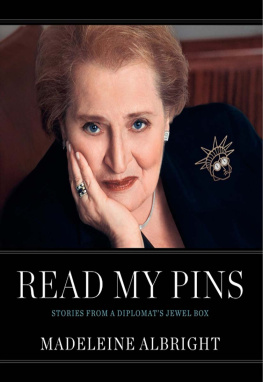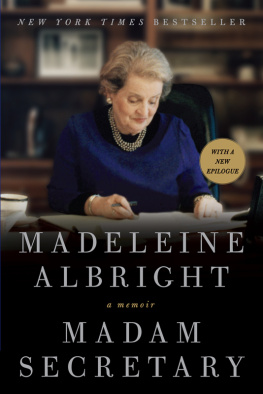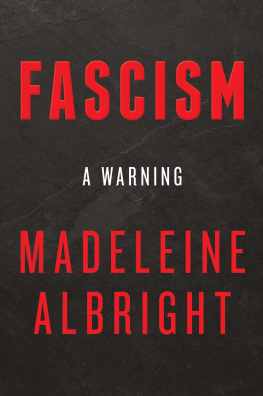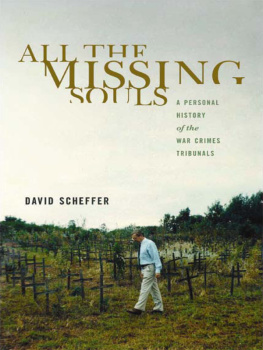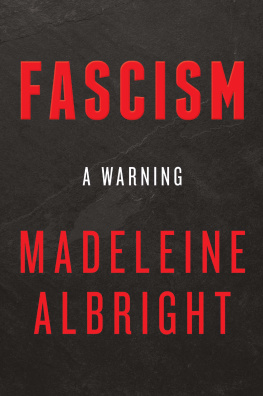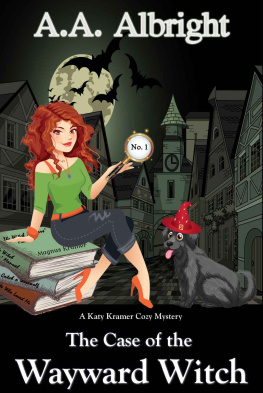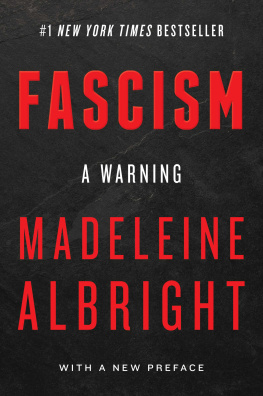Read My Pins
Stories from a Diplomats Jewel Box
Madeleine Albright
with
Elaine Shocas, Vivienne Becker, and Bill Woodward
Photography by John Bigelow Taylor
Photography Composition by Dianne Dubler


The United States Capitol, Monet.
See a pin, pick it up,
And all day youll have good luck.
See a pin, let it lay,
And your luck will pass away.
Nursery Rhyme

The Great Seal of the United States book locket and pin, Ann Hand.

Asymmetrical gold heart, Erwin Pearl

red heart and bow, Ann Hand

bejeweled heart, designer unknown

sparkling red heart, Ann Hand

interlocking hearts, Swarovski

purple heart, D.M. Lee

hammered metal heart, Omega
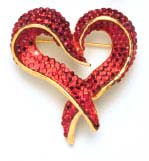
rhinestone bomb heart, designer unknown.
With deep appreciation to St. John Knits for its support of the book and to Bren Simon for her support of the exhibition.
This book is published in conjunction with the exhibition Read My Pins: The Madeleine Albright Collection organized by the Museum of Arts and Design, New York. After being shown at the Museum, the exhibition will tour to selected venues in the United States and around the world.

Gold ginkgo leaf, designer unknown

silver ginkgo leaf, designer unknown

copper ginkgo leaf, Beauvoir, the National Cathedral Elementary School

gold-stemmed ginkgo leaf, Fabrice.
In Six Memos for the Next Millennium , the great Italian short storywriter Italo Calvino recounts the legend of how the emperor Charlemagne was enchanted by a gold ring. Whoever or whatever possessed the ring held the power of bewitchment, from a deceased maiden to an archbishop and, ultimately, the lake into which the ring was cast. This small piece of jewelry took on magical powers, becoming an outward and visible sign that reveals the connection between people or between events. In addition to conveying information about the wearerher or his status, finances, and affinitiesjewelry has an impressive power to establish links among people, places, and events. Madeleine Albrights pins are nothing if not eloquent and often provocative communicators.
Secretary Albrights pins cannot be described as a collection in any traditional sense. Collectors usually set out with specific goals in mind as to what they intend to acquire and how they will secure the objects of desire, whether they be paintings, stamps, butterflies, or grandfather clocks. By contrast, Secretary Albrights collection has grown organically over the years in response to the changing circumstances and opportunities of her life and career. This is a collection that has been amplified and enriched by the events that have engaged their owner, providing a visible record of past experiences and future hopes.
There is a delightful randomness and whimsy to the pins that make up this highly personal assemblage. Sought out in settings ranging from jewelry stores and art galleries to airport souvenir stands and the booths of craft fair vendors, they first spoke to Secretary Albright, asking (sometimes demanding) to be included in her trove of wearable images. Their value as communication devices once recognized, they were then inducted into service as diplomatic aides; sometimes demure and understated, sometimes outlandish and outspoken, they became gentle implements of statecraft.

Alert Lady, Brit Svenni/Berit Kowalski. According to the designers, One eye is extra watchful as Madeleine Albright is always alert to the worlds problems.
The pins reveal a rich diversity of motifs and images. Angels, stars, balloons, American flags, and spaceships are juxtaposed with a menagerie of birds, bees, beetles, butterflies, fish, frogs, turtles, and snakes. A variety of garden flowers, sentimental hearts and bows, and mementos of specific events and holidays round out the collection.
Jewelry buffs typically focus their attention on the preciousness of the materials from which an item is madegold, silver, rubies, or diamondsor on the virtuosity of the craftsmanship revealed in its design. Secretary Albrights pins, however, are for the most part unremarkable in their monetary value and, except for some pieces of antique or fine jewelry, likely to be by anonymous designers, and fabricated from materials ranging from base metals to plastics and glass. Rhinestones and crystal take the lead roles over diamonds, electroplating over solid gold.
Of modest intent and manufacture, Secretary Albrights pins are of a kind that anyone could possess and wear. These are truly pins of the people, and part of Secretary Albrights pleasure in wearing the pins must come from her recognition of their democratic nature. To assemble so notable a collection of pins takes something much more elusive and significant than moneyit takes a magical combination of a collectors eye, which can spot and home in on its target, and an ability to recognize the communicative potential of what might be deemed ordinary things. Through her pins, Secretary Albright tells us a great deal about herselfher sense of humor and her humanityand does so with grace and flair.
It is especially gratifying to know that this delightful collection, with its engaging history and purpose, can be shared with so many through this publication and the memorable exhibition it accompanies.

